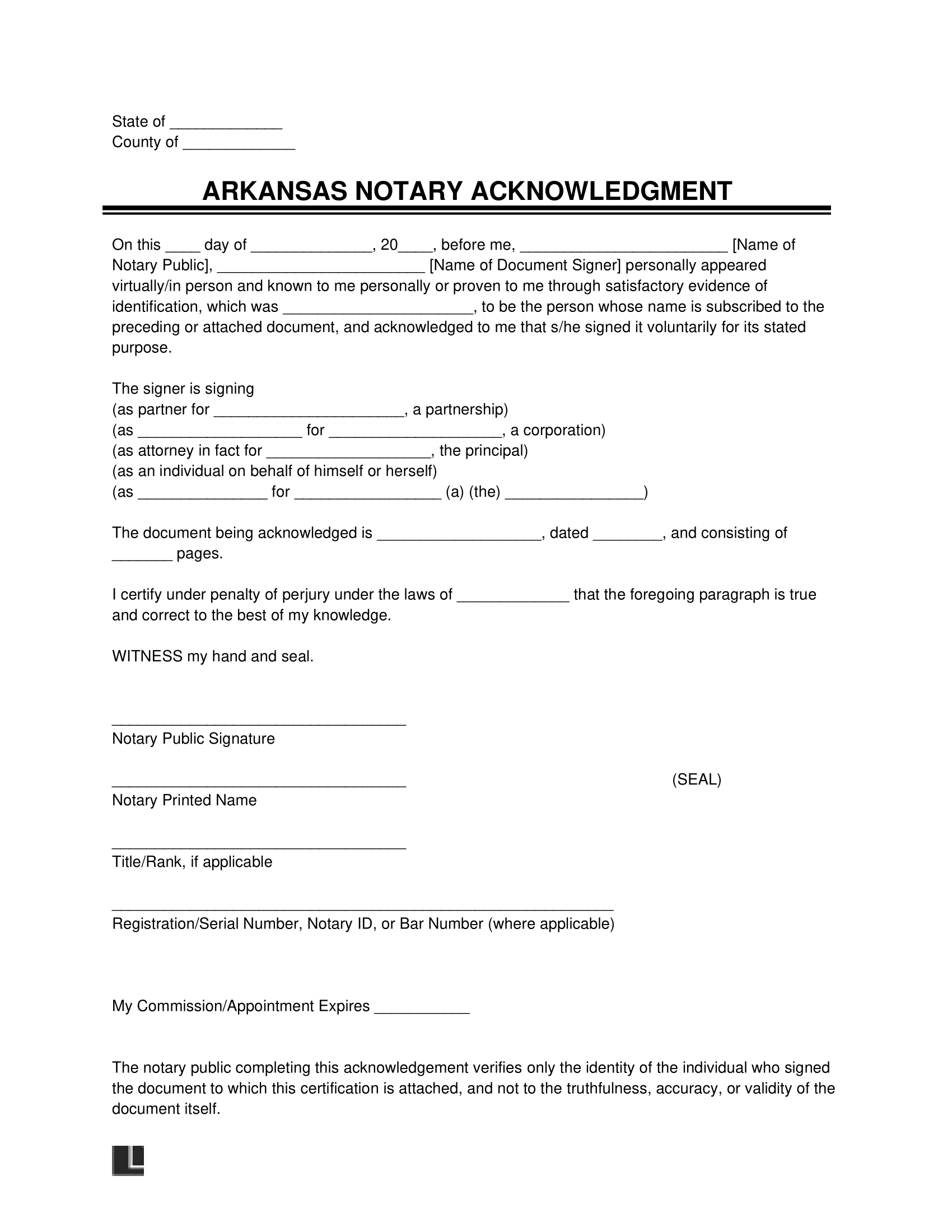An Arkansas notary acknowledgment form is a document used to validate the authenticity of signatures on legal documents within the state. The notary public certifies the signer’s voluntary presence and willingness to sign.
It’s advisable for individuals to wait and sign their documents before a notary to potentially prevent future legal delays. Once the notary verifies the signer’s identity and signs the form, the process is complete and the document is validated, ensuring its authenticity.
Legal Considerations
Statute: Arkansas Code, Title 16, Subtitle 4, Chapter 47.
Form of Acknowledgment: Under AR Code § 16-47-107, the acknowledgment must be in writing and comply with specific forms based on the entity executing the document. The choice of using present or past tense does not impact its validity. Additionally, its heading may specify either the county of the acknowledging officer’s residence or where the acknowledgment took place.
Notary Term of Commission: Ten years (AR Code § 21-14-101(a)(2)).
Notary Handbook: The Secretary of State’s Notary Public and eNotary Handbook is a valuable guide for proper notarization procedures in the state.
Is Online Notarization Legal in Arkansas?
Yes, as of April 26, 2021, Senate Bill 340 allows the online notarization of documents.
Under AR Code § 21-14-309, a notary public can conduct online notarizations, ensuring the following conditions are met:
- The online notary public is physically situated within the state, irrespective of the signer’s location.
- Verification of the signer’s identity involves personal knowledge by the notary, satisfactory evidence from a credible witness, or remote presentation of government-issued ID, followed by credential analysis and identity proofing.
- An audiovisual recording of the online notarial act is generated or arranged by the online notary public.
- For an individual located outside the U.S., the notary ensures the record is pertinent to U.S. jurisdiction or property and confirms no prohibition by the foreign state.
- The notary public must use secure communication technology and take steps to prevent unauthorized interception.
How to Notarize
Step 1 – Find a Notary
To locate a notary, you can perform an online search. Several other accessible locations offer notarization services, including banks and credit unions (with Arvest Bank having numerous branches statewide).
Additionally, UPS Stores and private notary services are commonly available for notarial needs.
A notary in this state can charge a fee for a notarial act if it’s considered reasonable by the notary and agreed upon by the client or principal prior to the act’s execution (AR Code § 21-6-309).
Additionally, the Notary Handbook provides that the fee for all notarizations (including online ones) is set at $5.
Step 2 – Bring the Paperwork
Submit all documentation to the notary public, ensuring they are fully completed except for the signature sections. All involved signers are required to be physically present in front of the notary at this stage.
Identification must be provided by each signer unless personally known by the notary. This ensures proper verification of the signers’ identities before proceeding with the notarization process.
Step 3 – Sign the Form
If the document has been signed beforehand, as is the case of acknowledgments, the signers need to make a declaration at the notary to prove the authenticity of their signatures.
However, for other notarial acts, all involved parties must sign the document in the presence of the notary public.
Step 4 – Administer an Affirmation
Certain notarial acts, such as jurats or sworn statements, need oaths affirming the accuracy of the document’s contents. In these cases, notaries are obliged to administer affirmations when notarizing specific documents, ensuring the validity and truthfulness of the statements.
Step 5 – Complete the Certification
Once all involved parties have been identified and their signatures verified, the notary is able to finalize a notarial certificate. The notarial act is deemed valid once the notary signs, dates, and affixes their stamp or seal on the certificate.
How to Verify a Notary
- Look through the State’s Notary Public Search.
- You can fill out relevant details such as the first or last name, expiration date, or city into the search function. Upon adding this information, you should proceed by clicking the “Search” button to access the results.
- The provided search results will include relevant details such as the notary public’s name, expiration date, city, county, and current notary status.
- To access more details, select the blue button located within the “Action” column.


